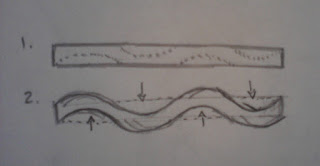The point of this project was to expose us to wood as a medium. With an 18" 2x4, the assignment was to rebuild in a way that not only utilizes the entire volume of the wood, but also makes it into something unique. My first idea was reminiscent of some of my old elementary art. I would gouge out curves from the block and simply shift them either directly on top of or directly below, depending on their previous
orientation. The picture above is how I originally framed this idea and that is exactly what I did in my first version. However, this felt much too simplistic to be called a final product, even with proper sanding. I thought the piece would be more interesting if I found a way to elevate the rounded cuts off of the main wood piece. I'd also need a way to anchor them in this raised position. My solution was to cut a 1/8" strip off the side before building the main body. At the same time, I cut two parallel slots of a corresponding width down the length of the 2x4. When the time came, I was able to successfully elevate rounded wedges by implementing my make-shift dowels. The picture to the left is what my final piece looks like. I feel it is most successful when positioned vertically like this because it draws along every curve to the top. When left positioned with two of the rounded surfaces as its base, it seems very awkward.
 My main issue with the piece lies with the negative space spanning through the entire length of the work. Perhaps an additional wave going through here would help fill the space, while also having continuity with the rest of the form. I feel that had there been another prototype before my declaring a final piece, there would be much better balance in the later version.
My main issue with the piece lies with the negative space spanning through the entire length of the work. Perhaps an additional wave going through here would help fill the space, while also having continuity with the rest of the form. I feel that had there been another prototype before my declaring a final piece, there would be much better balance in the later version. While writing that last section, I felt I should address my self critiquing process a bit. Several people have mentioned how it seems unusual for me to be harsh when discussing my own work. I don't think it's strange in the slightest, rather a necessity. It's important to be able to point out one's own failures, because its only from here that it is possible to learn and grow as an artist.



No comments:
Post a Comment